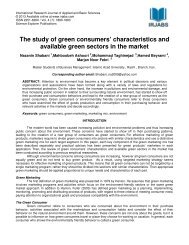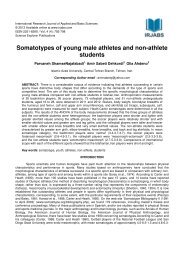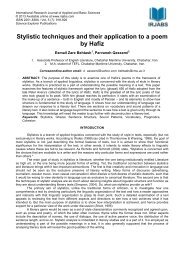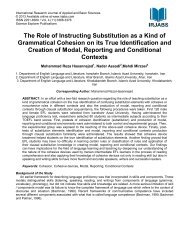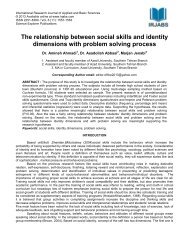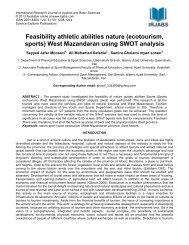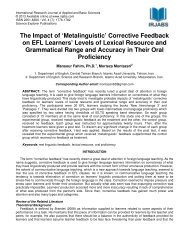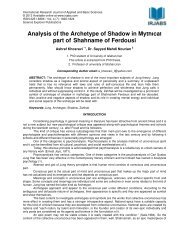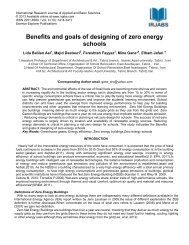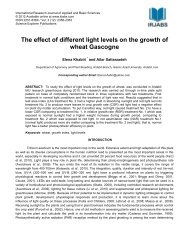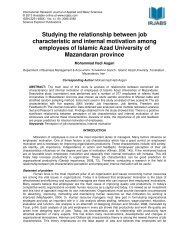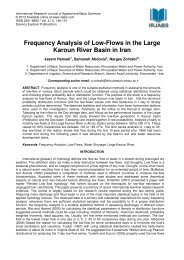The Effect of Conventional, Web-based, and Hybrid Teaching of Pre ...
The Effect of Conventional, Web-based, and Hybrid Teaching of Pre ...
The Effect of Conventional, Web-based, and Hybrid Teaching of Pre ...
Create successful ePaper yourself
Turn your PDF publications into a flip-book with our unique Google optimized e-Paper software.
Intl. Res. J. Appl. Basic. Sci. Vol., 4 (2), 393-401, 2013(Chamot, 2005). It builds in a self-evaluation phase for students to reflect on their use <strong>of</strong> strategies before going onto transfer the strategies to new tasks. <strong>The</strong> Grenfell <strong>and</strong> Harris (1999) model, however, leads the students througha cycle <strong>of</strong> six steps, then begin a new cycle. It provides initial familiarization with the new strategies, then hasstudents make action plans to improve their own learning. In the SSBI model, the teacher takes on a variety <strong>of</strong>roles in order to provide a scaffold for the students’ learning <strong>and</strong> using strategies appropriate to their own learningstyle.Although these models may have originally been proposed to be used in language learning classrooms,the utilization <strong>of</strong> these models can be extended to out-<strong>of</strong>-class environments. <strong>The</strong> comparison <strong>of</strong> these threemodels reveals that the most appropriate one to be used for the purpose <strong>of</strong> this study is that <strong>of</strong> Grenfell <strong>and</strong> Harris(1999) since it lends itself more to the three modes <strong>of</strong> instruction (conventional, web-<strong>based</strong>, <strong>and</strong> hybrid) which arethe focus <strong>of</strong> this study. This is so because SSBI relies on an extra component (i.e. learning styles) which isdispensed with here, <strong>and</strong> CALLA places great emphasis on the transfer <strong>of</strong> strategies from one task type to another(which is also a marginal factor in the present study).Table 1. Models for Language Learning Strategy InstructionSSBI* Model (Cohen, 1998) CALLA** Model (Chamot et al., 1999;Chamot, 2005)Grenfell & Harris (1999)Teacher as diagnostician: Helps studentsidentify current strategies <strong>and</strong> learning styles.Teacher as language learner: Shares ownlearning experiences <strong>and</strong> thinking processes.Teacher as learner trainer: Trains studentshow to use learning strategies.Teacher as coordinator: Supervises students’study plans <strong>and</strong> monitors difficulties.Teacher as coach: Provides ongoingguidance on students’ progress.<strong>Pre</strong>paration: Teacher identifies students’current learning strategies for familiar tasks.<strong>Pre</strong>sentation: Teacher models, names, <strong>and</strong>explains new strategy; asks students if <strong>and</strong>how they have used it.Practice: Students practice new strategy; insubsequent strategy practice, teacher fadesremainders to encourage independentstrategy use.Self-Evaluation: Students evaluate their ownstrategy use immediately after practice.Expansion: Students transfer strategies tonew tasks, combine strategies into clusters,develop repertoire <strong>of</strong> preferred strategies.Assessment: Teacher assesses students’ use<strong>of</strong> strategies <strong>and</strong> impact on performance.*Styles <strong>and</strong> Strategies-Based Instruction**Cognitive Academic Language Learning Approach(Adopted from Chamot, 2008)Awareness raising: Students complete a task,<strong>and</strong> then identify the strategies they used.Modeling: Teacher models, discusses value<strong>of</strong> new strategy, makes checklist <strong>of</strong> strategiesfor learner use.General practice: Students practice newstrategies with different tasks.Action planning: Students set goals <strong>and</strong>choose strategies to attain those goals.Focused practice: Students carry out actionplanning using selected strategies; teachersfade prompts so that students use strategiesautomatically.Evaluation: Teacher <strong>and</strong> students evaluatesuccess <strong>of</strong> action plan; set new goals; cyclebegins again.<strong>Web</strong>-Based Strategies-<strong>based</strong> InstructionAs an educational tool, technology finds a number <strong>of</strong> applications in <strong>and</strong> outside the classroom. Manyresearchers (McCrory, 2006; Oliver & Herrington, 2003; Tu, 2005) observe that the development <strong>of</strong> onlinetechnologies has brought new ways <strong>of</strong> learning <strong>and</strong> teaching. Whereas the traditional mode <strong>of</strong> instruction includedpresenting <strong>and</strong> storing information, web-<strong>based</strong> learning emphasizes communication <strong>and</strong> knowledge construction.<strong>The</strong> strongest distinction between the two is the linear approach <strong>of</strong> the former, which makes learners dependent onthe information received from the instructor, <strong>and</strong> the recursive approach <strong>of</strong> the latter, which views learners as coparticipantsin the learning process.Based on the purpose <strong>of</strong> the instruction <strong>and</strong> the technical base <strong>of</strong> a web-<strong>based</strong> program, the electronicdiscourse can take place synchronously or asynchronously (Sotillo, 2000). Synchronous interaction allows allparticipants to collaborate simultaneously in real time. Some examples are live chats <strong>and</strong> video conferences.Asynchronous interactions occur in a delayed manner as, for example, in threaded discussions <strong>and</strong> <strong>Web</strong> logs.Each has a specific effect on learning. Although collaboration <strong>and</strong> teacher facilitation are present in both types,asynchronous discussions allow for deeper analyses <strong>and</strong> integration <strong>of</strong> material, which is evident in the length <strong>of</strong>postings <strong>and</strong> expressiveness <strong>of</strong> the language (Serdyukov & Hill, 2004). <strong>The</strong>refore, asynchronous mode appears tobe more suitable for the purpose <strong>of</strong> time management <strong>and</strong> quality <strong>of</strong> responses in this study.A large number <strong>of</strong> studies on web-<strong>based</strong> second language writing (Cabot, 2000; Sullivan, 2006; Chuo,2007; Zaid, 2011, to name just a few) have proved the facilitating effect <strong>of</strong> web-<strong>based</strong> instruction.396



